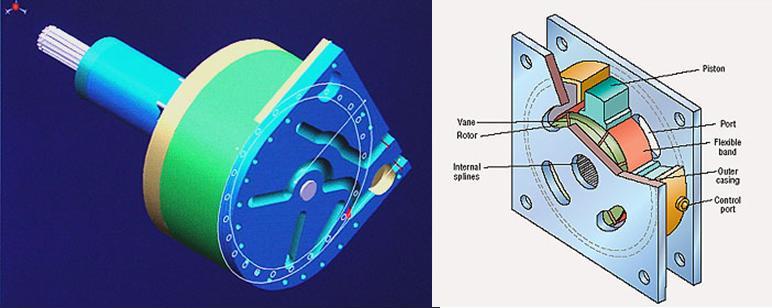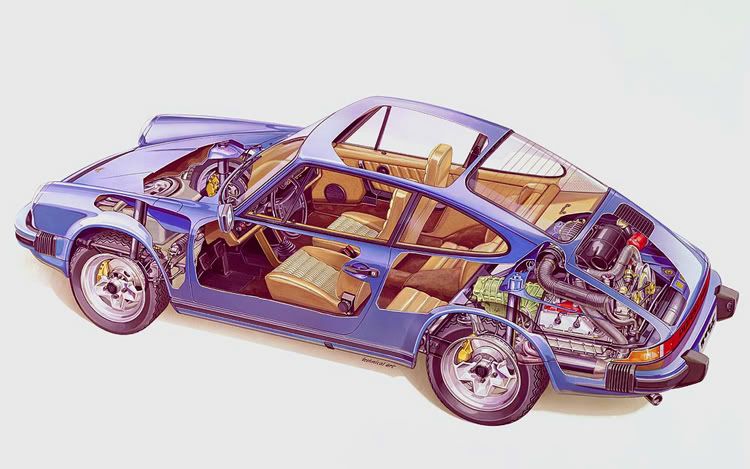Checkered:
The "mode of operation" seems relatively clear to me. I'm not sure if its in "A Connecticut Yankee in King Arthur's Court" that Mark Twain makes his protagonist say "I've never seen a machine whose purpose wasn't clear to me at first sight". I wish I could consult the guy...

We have Manchild in this forum that seems to have this same ability. My son, 8 years old, behaves the same way. I checked with him

and he understood "the thing" at once with a little coaching from dad. He even did not know what a hydraulic pump was but he got it quite fast: just as smart and handsome as dad!

I wait for MC to criticize my explanation and I will write to Mr. Tom Kasmer (for the first time in my life) to see if all of the following is "bull manure" or not.
You mention variable displacement pumps. I'm quite familiar with them because I used back hoes "once upon a time" at work. You mentioned also gear pumps (well, you gave the link for "regular" backhoes, where they are mentioned). The concept is similar in a gear pump, like the gerotor, but the implementation is different from variable vane-pumps, the "father" of hydristor. Here you have an animation of one:
http://www.mekanizmalar.com/vanepump.html.
In these vane pumps you could have a spring to "load" or push the vanes against the walls of the container when they are rotating at low speeds, but I think there is no need for them: on one hand, I imagine it must be a "mighty" spring to provide an hydraulic seal, on the other, I also imagine that the starting of the pump would become difficult and would scratch the container walls at low rpm and with low lubrication. Mr. Kasmer would not be able to achive 94% efficiency if he used springs THIS WAY and the belt would not last if the vanes rotated against it.
The seal between the vanes and the container, in a vane-pump is achieved mainly by "centrifugal force" (yes, I know centrifugal force doesn't exist and that I shall speak only of centripetal force, but I know some people won't get it). Anyway, centripetal or centrifugal, this force is enough to provide the sealing if I understand correctly a vane pump.
Now, the genius of the hydristor is to enclose the vanes inside a flexible steel belt: this way the volume of the liquid "inside" the belt is more or less constant (unless it adopts extreme shapes, which it doesn't) but you have, in essence, a vane pump with a variable shape container. Trough the use of "pistons" you can change the shape of the steel belt. Another characteristic (this is another of my wild guesses, again, just by "looking at it") is that the hydristor NEEDS springs to push the vanes against the steel belt: this way you "anchor" the belt at the start of the rotation of the gizmo, and it causes the steel belt to rotate with the vanes! The vanes move "in and out" of the rotor as the belt changes shape. I usually provide enlightening explanations, but in this case I cannot think of a simile. No pump I know behaves like that. This way you achieve a unique pump where you have taken away the frictional losses associated with fixed band designs, like "primitive" conical "gears" and bands.
You don't want to "contain the liquid" inside the steel belt: you need to push it out of the vane pump container, that is, the steel belt. That's the reason why there is a communication between the "inner chamber", were the vanes are, and the "outer chamber", where the fluid under pressure is.
Take a look at the vane pump animation in the link I provided: if you "moved" the chamber to the right (the container is displaced to the left of the vertical simmetry axis, that's why it works), you would reverse the action of the vane pump: it would not pump the liquid upwards but downwards. Do you follow me? I'm assuming the rotor is turning clockwise on both images and that blue is low pressure and red is high.

Now, what the hydristor does is altering the shape of the case or container through the action of pistons. In the following figure you can easily imagine that moving from the "configuration" on the left image to the one on the right side of the image will change the vane pump action from expelling the fluid from the top/down chambers formed by the belt to the left/right chambers, as you state.

Notice that in the other figure you provided (sorry for posting all the figures, I know many people would not follow the links if I did not show them on the post) the "pistons" on the left/right sides are "under" valves (that’s what they seem to me) called "control ports".

This means that using these ports you alter the shape of the thing. Now, I imagine that the up/down pistons move freely : if you "push inside" the pressure chamber the left/right pistons, the belt changes shape and COULD push those up/down pistons.
As you correctly points out, Mr. Kasmer doesn’t show how the control of these left/right pistons is achieved. Here, my guessing becomes hazier: you could try to find the schema of an hydraulic pump for construction machinery. In these hydraulic circuits you have a “cross valve” that equilibrates the pressure and allows you to vary the amount of fluid that is “returned” to the main tank to keep the “primary” engine under the same workload, no matter how much pressure the operator needs to put through to the pistons that move the machine, no matter if you have the thing at rest or if you are pushing the largest load it can handle. I would use a similar “double” circuit. This is what I imagine could be an alternative to freely floating up/down pistons. Check here:
http://www.automorrow.com/ddbase/automo ... dex_id=415
On that link you’ll find the phrase “Inside the Hydristor you will find two independent circuits which are dual pressure balanced to minimize the torque shaft load”. Mr. Kasmer COULD balance charges, the same way a cross valve (I don’t know the English name) works in a normal hydraulic engine.
Finally, you could also direct the "relative" pressure of the exit ports to different wheels (that's how a tractor turns) or equilibrate the torque on the wheels the way a differential does. The article on the Mag One and the photo it has, without a differential, made me wonder about that. I also thought that, if you pushed the control ports "midway", you could make the belt to become circular, putting the machine in "neutral".
Thanks, Checkered. If you hadn't asked I wouldn't have provided forum members with so many opportunities to: a) criticize my assumptions or b) confirm I'm "losing it".








